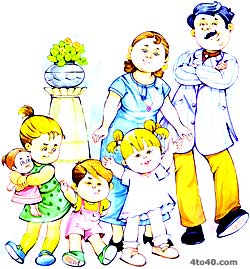This Is My Father – Nursery Rhyme: A nursery rhyme is a traditional poem or song for children in Britain and many other countries, but usage of the term only dates from the late 18th / early 19th century. The term Mother Goose rhymes is interchangeable with nursery rhymes.
From the mid-16th century nursery rhymes begin to be recorded in English plays, and most popular rhymes date from the 17th and 18th centuries. The first English collections, Tommy Thumb’s Song Book and a sequel, Tommy Thumb’s Pretty Song Book, were published by Mary Cooper in 1744. Publisher John Newbery’s stepson, Thomas Carnan, was the first to use the term Mother Goose for nursery rhymes when he published a compilation of English rhymes, Mother Goose’s Melody, or, Sonnets for the Cradle (London, 1780).
This Is My Father Nursery Rhyme: Sanjay Ahluwalia
This is my father, nice and kind.
This is my mother, gentle mind.
This is my sister, playing with a doll.
This is my brother, still to grow tall.
This is my family, I love them all.

∼ Sanjay Ahluwalia
Early Nursery Rhymes
A French poem, similar to “Thirty days hath September“, numbering the days of the month, was recorded in the 13th century. From the later Middle Ages there are records of short children’s rhyming songs, often as marginalia. From the mid-16th century they begin to be recorded in English plays. “Pat-a-cake, pat-a-cake, baker’s man” is one of the oldest surviving English nursery rhymes. The earliest recorded version of the rhyme appears in Thomas d’Urfey’s play The Campaigners from 1698. Most nursery rhymes were not written down until the 18th century, when the publishing of children’s books began to move from polemic and education towards entertainment, but there is evidence for many rhymes existing before this, including “To market, to market” and “Cock a doodle doo“, which date from at least the late 16th century. Nursery rhymes with 17th century origins include, “Jack Sprat” (1639), “The Grand Old Duke of York” (1642), “Lavender’s Blue” (1672) and “Rain Rain Go Away” (1687).
 Kids Portal For Parents India Kids Network
Kids Portal For Parents India Kids Network







